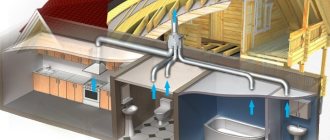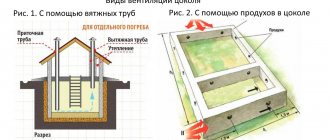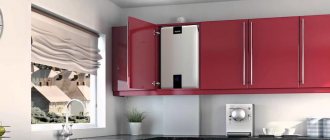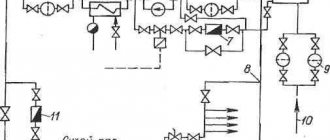What is considered the heated area of a private house?
The total living area is calculated as follows: the areas of rooms and utility rooms are added up.
Utility rooms are considered to be bathrooms, toilets, storage rooms, built-in closets, corridors, as well as stairs located in the house. The concept of living space is practically not used in law and in practice and is more theoretical than applied. It is often necessary to know the area of the walls. This can be useful when drawing up a house plan, purchasing wall materials (bricks, blocks, etc.), insulation, materials for interior and exterior wall decoration. Calculating the area of the walls of a house is very simple. To do this, you need to measure each of the walls and calculate their area, and then add the resulting values.
How to find out what is included in the living space of a private house, and how it can be calculated
Each future homeowner needs to learn how to independently measure the total and living area in order to check the compliance of the finished building with the data stated in the project. To do this, the room must be cleared of furniture, and then measure the length and width of the room. The resulting dimensions are multiplied, thus measuring the size of each room in the house.
Knowledge of all these concepts allows you to understand what size a house should be and determine the requirements for the developer and designer. In addition, the total and living area are indicated in advertisements when searching for a buyer for a house.
Requirements for determining the area of a building or premises
3. For premises in buildings constructed according to standard designs from prefabricated prefabricated structures with a standard layout on the floors, it is allowed to determine the areas by the basement, first and standard floors. For subsequent floors, the area can be taken as standard, with the exception of rooms in which there are layout changes.
I. General requirements for determining areas
So, to determine the area and total area of a building (room), you need to refer to the area of the simplest geometric figure (rectangle, trapezoid, right triangle, etc.). Or divide such an object into the latter and sum up their areas.
We recommend reading: Poor Perm Territory Benefits
Both balconies and loggias are considered summer rooms, regardless of whether they are glazed or not. In addition to them, summer premises include a veranda and a terrace, but they are mainly related to manor houses.
How to determine the heated area in a private house
With complex shapes of the internal volume of a building, the heated volume is defined as the volume of space limited by the internal surfaces of external enclosures (walls, roofing or attic floor, basement).
na is the average rate of air exchange of a building during the heating period, h -1, adopted according to the design standards of the relevant buildings: for residential buildings - based on the specific standard air flow of 3 m 3 / h per 1 m 2 of residential premises and kitchens; for general education institutions – 16–20 m 3 /h per person; in preschool institutions - 1.5 h -1, in hospitals - 2 h -1.
See for yourself
“What is excess space? I have payment benefits, the apartment is 59 sq. m. meters, for 42 I pay at a reduced price, and for 17 they charge me at increased prices. Are such calculations correct? Ivan Petrovich."
– In short, surplus is space occupied in excess of the social norm. Prices for services for the maintenance and repair of housing and heating for the area occupied within the established standards, and increased prices for the area exceeding them (surplus), are determined in the Moscow government decree of December 6, 2005 No. 983-PP “On approval of prices, rates and tariffs for housing and communal services for the population for 2006" (as amended on February 7, 2006).
In accordance with this resolution, the social norm for housing area is 33 square meters for a citizen living alone. meters of total living space; for a family of two people – 42 sq. meters of total area; for a family of three or more people – 18 sq. meters of total living space for each family member.
The established norm is defined as social for a family of a certain composition plus seven square meters. meters for each citizen registered in this area. This norm is paid at prices regulated by the Moscow government. The remaining area occupied in excess of the established norm (surplus area) must be paid at an increased price reflecting the actual cost. At the same time, increased payment for services for the maintenance and repair of residential premises and heating for excess space is not charged: - from pensioners living alone; – from disabled people living alone; – from orphans under the age of 18 for the area owned by them; – from citizens occupying apartments located on the ground floor; – from families consisting of pensioners and (or) disabled people; – from families consisting of pensioners and (or) disabled people and their dependent children under the age of 16 years; – from single citizens living in communal apartments; – from owners of residential premises paying for services for the maintenance and repair of residential premises and heating at the actual cost; – from citizens living in houses or apartments recognized in accordance with the established procedure as unsafe or unsuitable for habitation; – from citizens who have the right to additional space provided to them for health reasons.
In addition to the above categories, citizens who have the right to additional living space occupied in excess of the established standards are exempt from paying for excess space at increased rates. This is stated in the Moscow government decree No. 360 dated April 27, 1999, “On the progress of the housing and communal services reform program in Moscow” (as amended by the Moscow government resolutions No. 841 dated September 7, 1999, and No. 221- dated March 26, 2002). PP). Citizens who have the right to additional space provided to them for medical reasons pay for the entire excess area at the rates that are established for the housing area occupied within the norms - regardless of the size of the additional space to which they are entitled.
What is considered a heated area in a private house?
the total area of the floors (including attic, heated basement and basement) of the building, measured within the internal surfaces of the external walls, including the area of stairwells and elevator shafts; for public buildings, the area of mezzanines, galleries and balconies of auditoriums is included. (See: TSN 23-328-2001 of the Amur Region (TSN 23-301-2001 JSC). Standards for energy consumption and thermal protection.)
TSN 23-333-2002: Energy consumption and thermal protection of residential and public buildings. Nenets Autonomous Okrug
— Terminology TSN 23 333 2002: Energy consumption and thermal protection of residential and public buildings. Nenets Autonomous Okrug: 1.5 Degree day Dd °С×day Definitions of the term from various documents: Degree day 1.6 Coefficient of glazing of the façade of a building... ... Dictionary-reference book of terms of normative and technical documentation
CALCULATION OF HEATED AREA AND VOLUMES OF A BUILDING
- wife husband),
- their minor children (under 18 years old),
- unmarried adult children recognized as disabled since childhood of groups I and II or disabled in group I;
- a person who lives with a group I war disabled person and cares for him, provided that the war disabled person is not married;
- disabled parents;
- a person who is under the guardianship or trusteeship of a citizen entitled to benefits and lives with him.
Basic terms in construction
For all consumers entitled to benefits in paying for housing and communal services, the old social norm for rent and heating remains in effect - 21 m2 of heated area for each person entitled to benefits, and an additional 10.5 m2 per family.
Recently, owners of apartments located on the top floors have often practiced redevelopment. As a result of such individual construction manipulations, the loggia becomes part of the heated zone of the room. Then it is definitely included in the total area of the apartment.
The latest provisions of the Housing Code of the Russian Federation do not consider the inclusion of loggias in the total living area of the apartment. However, you should not assume that representatives of construction companies will transfer ownership of them for free. After all, decent material and financial resources were spent on this.
Controversial situations
Often, under the guise of various interpretations of the existing legislative framework, unscrupulous developers deceive their shareholders. And BTI, guided by its internal regulations, does not include loggias in the total living area. However, their footage is required to be paid.
Previously, according to the established law regarding housing rights, balconies and loggias were not such. That is, they were not included in the number of additional premises necessary for the life and recreation of residents. Consequently, such premises could not be included in the cost of common housing.
. The total area of the apartment is determined as the sum of the areas of its premises, built-in wardrobes, as well as the areas of loggias, balconies, verandas, terraces and cold storage rooms, calculated with the following reduction factors: for loggias - 0.5, for balconies and terraces - 0.3, for verandas and cold storage rooms - 1.0.
We recommend reading: Benefits for Persons Living in the Chernobyl Damage Zone
How does the BTI take into account the area of a balcony or loggia in the total area of the apartment?
Due to constant changes in the current legislation of the Russian Federation, many controversial issues always arise in practice. Many of them are regulated by certain provisions of various documents and by-laws. However, all of them are sometimes completely inaccessible to ordinary citizens for full familiarization.
TSN 23-311-2021: Energy efficiency of residential and public buildings. Standards for thermal protection of buildings. Smolensk region
— Terminology TSN 23 311 2021: Energy efficiency of residential and public buildings. Standards for thermal protection of buildings. Smolensk region: 1.5. Degree days °С ∙ days Definitions of the term from various documents: Degree days. Living area m2... ... Dictionary-reference book of terms of normative and technical documentation
Previously, according to the established law regarding housing rights, balconies and loggias were not such. That is, they were not included in the number of additional premises necessary for the life and recreation of residents. Consequently, such premises could not be included in the cost of common housing.
Is the loggia included in the area of the apartment?
Due to constant changes in the current legislation of the Russian Federation, many controversial issues always arise in practice. Many of them are regulated by certain provisions of various documents and by-laws. However, all of them are sometimes completely inaccessible to ordinary citizens for full familiarization.
If the management company incorrectly calculates the cost of heating due to the total area incorrectly indicated in the documents, it is necessary to reissue the technical passport, after which the corresponding changes are made to the cadastral passport and certificate of ownership. After this, the management company will have to recalculate.
Calculation of heating by room area
The calculator below provides a calculation for a multilayer structure, including a base layer (item 1), existing insulation (if any) (item 2), a layer of internal (item 3) and external (item 4) finishing. If there are no layers in reality, then this item in the calculator is simply not filled in.
As shown above, the floor is one of the significant sources of heat loss. This means that it is necessary to make some adjustments to account for this feature of a particular room. The correction factor “g” can be taken equal to:
Gas floor heating boilers: general information
Another important aspect: the power of a floor-standing gas boiler, which is declared by its manufacturer, can usually only be achieved if the nominal pressure in the lines is 13-20 mbar. But in fact this pressure is below 10 mbar. That is why it is better to purchase a floor-standing gas boiler with a little more power.
Thus, a heating boiler is a special device designed to heat a room. Sometimes these types of boilers are also used to heat water. They are divided depending on what energy carrier is used, on the purpose and principle of fastening. Today, the best option is to use mains gas - this can be seen by even examining the rating of floor-standing gas heating boilers. After all, gas is not only relatively cheap, but also practical. In addition, in the CIS countries gas is the predominant type of fuel.
How to determine the heated area in a private house
- The area of niches with a height of 2 meters or more should be included in the total area of the premises in which they are located. The area of arched openings should be included in the total area of the room, starting from a width of 2 meters
- the floor area under the flight of internal stairs, with a height from the floor to the bottom of the protruding structures of the flight of 1.6 meters or more, should be included in the total area of the room in which the stairs are located
- the area occupied by protruding structural elements and heating stoves, as well as located within the doorway, should not be included in the total area of the premises.
The energy passport of a building includes such a criterion as “Area of heated premises”. Let's consider a regular MKD. With citizens’ apartments, the question is clear - clause 1.8 of the Resolution of the State Committee of the Russian Federation on Construction, Architectural and Housing Policy dated 02.23.1999 No. 9 “On approval of the methodology for planning, accounting and calculating the cost of housing and communal services”. Let's look at the common property of the apartment building. In TSN we read - “the heated area of a building should be defined as the area of floors (including the attic, heated basement and basement) of the building, measured within the internal surfaces of the external walls, including the area occupied by partitions and internal walls. Ministry of Regional Development of Russia dated November 22, 2012 N 29433-VK/19 “On clarification on the issue of taking into account in calculating the amount of payment for utility services the values of the total area of all premises in an apartment building, the total area of premises included in the common property in an apartment building, the total area of all residential premises (apartments) and non-residential premises in an apartment building, as well as on the issue of taking into account the value of the total area of premises that are part of the common property in an apartment building, when determining standards for the consumption of utilities for general house needs"
How to calculate the volume of a heated room – as-interior.ru
1. The heated area of the building should be defined as the area of the floors (including the attic, heated basement and basement) of the building, measured within the internal surfaces of the external walls, including the area occupied by partitions and internal walls. In this case, the area of staircases and elevator shafts is included in the floor area.
The heated area of the building does not include the area of warm attics and basements, unheated technical floors, basement (underground), cold unheated verandas, unheated staircases, as well as a cold attic or part of it not occupied as an attic.
Explanations for calculations
We sequentially enter the data into the fields of the calculator.
- First of all, we will determine the climatic features - indicating the approximate minimum temperature characteristic of the region of residence in the coldest decade of winter. Naturally, we are talking about normal temperatures for the region, and not about some “records” in one direction or another.
By the way, of course, this field will not change when calculating for all rooms of the house. In other fields, variations are possible.
- Next comes a group of two fields, which indicate the area of the room (exactly) and the height of the ceilings (select from the list).
- The following group of data takes into account the location of the room:
— Number of external walls , that is, in contact with the street (selection from the list, from 0 to 3).
— The location of the external wall relative to the cardinal direction. There are walls that regularly receive a charge of thermal energy from the sun's rays. But the northern wall, for example, never sees the sun at all.
- If in the area where the house is located, there is a predominance of a certain direction of the winter wind (stable wind rose), then this can also be taken into account. That is, indicate whether the outer wall is on the windward, leeward or parallel side to the wind direction. If there is no such data, then we leave it by default, and the program will calculate as for the most unfavorable conditions.
— Next, it is indicated how insulated the walls are . Select from three proposed options. More precisely, even of the two, since in a house with generally uninsulated walls, starting heating is absolute nonsense.
- Two similar fields of piglets indicate what the room is adjacent to “vertically”, that is, what is located above and below. This will help to estimate the size of heat loss through floors and ceilings.
- The next group concerns indoor windows. What is important here is their number, size, and type, including the features of double-glazed windows. Based on the totality of this data, the program will develop a correction factor to the calculation result.
- Finally, the amount of heat loss is seriously affected by the presence in the room of doors facing the street, onto the balcony, into a cold entrance, etc. If the doors are used regularly throughout the day, then any opening of them is accompanied by an influx of cold air. It is clear that this requires compensation in the form of additional thermal power.
All data has been entered - you can press the button. As a result, the user will immediately receive the desired value of thermal power for a specific room.
As already mentioned, the sum of all values will give the result for the entire house (apartment) as a whole, in kilowatts.
the heating boiler is also selected based on this value, considering it the minimum . And it is this total value that will be needed when the time comes to calculate the real cash costs of operating the heating system.
And the data for each room is also very useful - for selecting and arranging heating radiators, or for choosing the appropriate model of electric heater.
Calculation of heated areas and volumes of a building
5.4 Thermal insulation of external walls should be designed to be continuous in the plane of the building facade. When using combustible insulation, it is necessary to provide horizontal cuts from non-combustible materials at a height of no more than the height of the floor and no more than 6 m.
Fencing elements such as internal partitions, columns, beams, ventilation ducts and others should not violate the integrity of the thermal insulation layer.
Air ducts, ventilation ducts and pipes that partially pass through the thickness of external fences should be buried to the surface of the thermal insulation on the warm side. It is necessary to ensure a tight connection of the thermal insulation to the through heat-conducting inclusions.
In this case, the reduced heat transfer resistance of the structure with heat-conducting inclusions must be no less than the required values.
5.11 It is recommended to design the filling of gaps at the junctions of windows and balcony doors with external wall structures using foaming synthetic materials.
All window and balcony doors must have sealing gaskets (at least two) made of silicone materials or frost-resistant rubber with a durability of at least 15 years (GOST 19177).
It is recommended to install glass in windows and balcony doors using silicone mastics. The blind parts of balcony doors should be insulated with heat-insulating material.
How to find out what is included in the living space of a private house, and how it can be calculated
If the management company incorrectly calculates the cost of heating due to the total area incorrectly indicated in the documents, it is necessary to reissue the technical passport, after which the corresponding changes are made to the cadastral passport and certificate of ownership. After this, the management company will have to recalculate.
- If the building has niches whose height is less than 2 m, they cannot be taken into account as part of the living area of the room.
- If the area of the space under the flight of stairs is no more than one and a half meters, it will also not be taken into account when assessing the size of the house.
Private house projects
The area of a residential building does not include underground areas for ventilation of a residential building, unused attic, technical underground, technical attic, non-apartment utilities with vertical (in channels, shafts) and horizontal (in interfloor space) wiring, vestibules, porticoes, porches, external open staircases and ramps, as well as the area occupied by protruding structural elements and heating stoves, and the area within the door
Interesting: What Documents Are Needed? Military Pensioner Benefit for Camp Children 2020
A.2.1 The area of apartments is determined as the sum of the areas of all heated premises (living rooms and auxiliary premises intended to meet household and other needs) without taking into account unheated premises (loggias, balconies, verandas, terraces, cold storage rooms and vestibules).
Source: https://xn--80alqibft0g1a.xn--p1ai/montazh-i-remont/kak-poschitat-otaplivaemyj-obem-zdaniya.html
How to correctly calculate the area of a house in 2021
- future housing is being designed;
- it is necessary to carry out construction and it is necessary to calculate the amount of material required in this case;
- carrying out finishing work indoors - usually the consumption of materials is calculated based on square meters;
- for registration of home ownership in the authorities of Justice;
- if it is necessary to rent out housing;
- repair work both indoors and outdoors;
- execution of a housing purchase and sale agreement;
- preparation of a special technical plan for the Bureau of Technical Expertise.
Dear readers! The article talks about typical ways to resolve legal issues, but each case is individual. If you want to find out how to solve your particular problem , contact a consultant:
What documents are needed when increasing the heated area in a private house?
It is worth noting that the process may be a little more complicated if the building belongs to the list of cultural or historical heritage sites. In this case, interested parties will have to visit several authorities, including the territorial department responsible for the protection of architectural monuments.
The application must be accompanied by a technical passport for each room. The process of approving redevelopment in a private house does not differ from the procedure for registering changes to premises in apartments in multi-storey buildings.
Heated area of a residential building
I pay for the central heating of the apartment according to the tariff (without a meter). The registration certificate for the apartment states: Living area - 55.8 sq.m., Area of auxiliary premises - 18.4 sq.m., Total area - 74.2 sq.m. The personal invoice for payment for heating of LUKOIL-Heat Transport Company LLC states: Heated area 62.2 sq. m. m.
That is, 1.8 kW of power is needed per hour to heat 18 square meters. This result must be divided by the amount of heat that the heating radiator section produces per hour. If the data in his passport indicates that this is 170 W, then the next stage of the calculation looks like this:
What area is considered heated in an apartment?
5.4.2 When determining the area of the attic floor, the area with a height up to a sloping ceiling of 1.2 m with an inclination of 30° to the horizon is taken into account; 0.8 m - at 45° - 60°; at 60° or more - the area is measured up to the baseboard.
DETERMINATION OF HEATED AREA AND VOLUME OF BUILDINGS
That is, 1.8 kW of power is needed per hour to heat 18 square meters. This result must be divided by the amount of heat that the heating radiator section produces per hour. If the data in his passport indicates that this is 170 W, then the next stage of the calculation looks like this:
The power of radiators is indicated for a system with a high temperature thermal regime. If the heating system of your home operates in medium-temperature or low-temperature thermal mode, additional calculations will have to be made to select batteries with the required number of sections.
If you used the method of calculating by area for a room with a non-standard wall height, then to clarify the result you will have to take it into account. The coefficient can be found out as follows: divide the existing ceiling height by the standard height, which is 2.7 meters. Thus we get the following numbers:
Walls and ceiling
- High temperature mode: 90/70/20 (supply temperature - 90 °C, return -70 °C, average room temperature is taken to be 20 °C). We calculate the thermal pressure as follows: (90 + 70) / 2 – 20 = 60 °C;
- Medium temperature: 75/65/20, thermal pressure – 50 °C.
- Low temperature: 55/45/20, thermal pressure – 30 °C.
The heated area of the building does not include the area of warm attics and basements, unheated technical floors, basement (underground), cold unheated verandas, unheated staircases, as well as a cold attic or part of it not occupied as an attic.
TSN 23-329-2021: Energy efficiency of residential and public buildings. Standards for thermal protection. Oryol region - Terminology TSN 23 329 2021: Energy efficiency of residential and public buildings. Standards for thermal protection. Oryol region: 1.5 Degree day Dd °С day Definitions of the term from various documents: Degree day 1.6 Glazing coefficient ... Dictionary-reference book of terms of normative and technical documentation
Calculation of heating by room area
For buildings located in closed areas, this indicator is not so important. However, in open areas, strong winds can significantly shift the thermal balance of a building. In addition, the leeward side will be more protected from heat loss than the windward side - there the heat will leave the room faster.
The procedure and rules for calculating payments for housing and communal services are regulated by the rules approved by Decree of the Government of the Russian Federation of May 06, 2021 No. 354 On the provision of utility services to owners and users of premises in apartment buildings and residential buildings
We recommend reading: Benefits for the Unemployed in 201
Calculation of heating radiators - how not to go wrong with the number of sections
Private houses and large modern apartments do not fall under standard calculations - there are too many nuances to take into account. In these cases, you can use the most accurate calculation method, which takes these nuances into account. Actually, the formula itself is very simple - even a schoolchild can handle it; the main thing is to correctly select all the coefficients that take into account the features of a house or apartment that affect the ability to save or lose thermal energy. So here's our exact formula:
The most important thing is not to trust the numbers announced at random by all sorts of “consultants” who tell you by eye (even without seeing the room!) the number of heating sections. As a rule, it is significantly overestimated, which is why you will constantly overpay for excess heat, which will literally go out through the open window. We recommend using several methods for calculating the number of radiators.
How to calculate the number of heating radiator sections
In order for heat transfer and heating efficiency to be at the proper level, when calculating the size of radiators, you need to take into account the standards for their installation, and not at all rely on the size of the window openings under which they are installed.
The heat transfer is affected not by its size, but by the power of each individual section, which are assembled into one radiator. Therefore, the best option would be to place several small batteries, distributing them around the room, rather than one large one. This can be explained by the fact that heat will enter the room from different points and warm it up evenly.
Each individual room has its own area and volume, and the calculation of the number of sections installed in it will depend on these parameters.
Calculation based on room area
To correctly calculate this amount for a specific room, you need to know some rules:
You can find out the required power for heating a room by multiplying the size of its area (in square meters) by 100 W, while:
- The radiator power is increased by 20% if two walls of the room face the street and there is one window in it - this could be an end room.
- The power will have to be increased by 30% if the room has the same characteristics as in the previous case, but has two windows.
- If the window or windows of the room face northeast or north, which means there is minimal sunlight, the power needs to be increased by another 10%.
- A radiator installed in a niche under a window has reduced heat transfer; in this case, the power will have to be increased by another 5%.
The niche will reduce the energy output of the radiator by 5%
If the radiator is covered with a screen for aesthetic purposes, then heat transfer is reduced by 15%, and it also needs to be replenished by increasing the power by this amount.
Screens on radiators are beautiful, but they will take up to 15% of the power
The specific power of the radiator section must be indicated in the passport that the manufacturer encloses with the product.
Knowing these requirements, you can calculate the required number of sections by dividing the resulting total value of the required thermal power, taking into account all the specified compensating corrections, by the specific heat transfer of one section of the battery.
The resulting calculation result is rounded to a whole number, but only up. Let's say there are eight sections. And here, returning to the above, it should be noted that for better heating and heat distribution, the radiator can be divided into two parts, four sections each, which are installed in different places in the room.
Each room is calculated separately
It should be noted that such calculations are suitable for determining the number of sections for rooms equipped with central heating, the coolant in which has a temperature of no more than 70 degrees.
This calculation is considered quite accurate, but the calculation can be done in another way.
Calculation of the number of sections in radiators based on the volume of the room
The standard is considered to be a thermal power ratio of 41 W per 1 cubic meter. meter of room volume, provided that it contains one door, window and external wall.
To make the result clearly visible, for example, you can calculate the required number of batteries for a room of 16 square meters. m. and ceiling, height 2.5 meters:
16 × 2.5= 40 cubic meters
Next you need to find the value of the thermal power, this is done as follows
41 × 40=1640 W.
Knowing the heat transfer of one section (it is indicated in the passport), you can easily determine the number of batteries. For example, heat transfer is 170 W, and the following calculation is performed:
1640 / 170 = 9,6.
After rounding, the number 10 is obtained - this will be the required number of sections of heating elements per room.
There are also some features:
- If a room is connected to an adjacent room by an opening that does not have a door, then it is necessary to calculate the total area of the two rooms, only then will the exact number of radiators for heating efficiency be determined.
- If the coolant has a temperature below 70 degrees, the number of sections in the battery will have to be increased proportionally.
- When double-glazed windows are installed in the room, heat losses are significantly reduced, so the number of sections in each radiator can be reduced.
- If the premises have old cast iron batteries installed, which were quite capable of creating the desired microclimate, but there are plans to replace them with some modern ones, then it will be very easy to calculate how many of them will be needed. One cast iron section has a constant heat output of 150 W. Therefore, the number of installed cast iron sections must be multiplied by 150, and the resulting number is divided by the heat transfer indicated for the sections of new batteries.
Heated area of the apartment: was it calculated correctly?
A: According to Article 15 of the Housing Code of the Russian Federation, residential premises are recognized as isolated premises, which are real estate and are suitable for permanent residence of citizens (meets established sanitary and technical rules and regulations, and other legal requirements). The total area of a residential premises consists of the sum of the area of all parts of such premises, including the area of auxiliary premises intended to satisfy citizens' household and other needs related to their residence in residential premises, with the exception of balconies, loggias, verandas and terraces. In accordance with the Rules for the provision of utility services to citizens, approved by Decree of the Government of the Russian Federation of May 23, 2006 No. 307, when calculating the amount of heating fees, the total area of the residential premises is taken into account
.
Thus, the balcony and loggia are not included in the heated area of the living space, but the bathroom and toilet are.
Probably, in your case, the “heated area” indicator was calculated before the Rules for the Provision of Public Utilities (2006) came into force by excluding from the total area of the apartment the areas of unheated premises (loggias, balconies, verandas, terraces and cold storage rooms, vestibules) on the basis rules for calculating area.
This can be confirmed by tech. passport for the apartment.
What is included in the living and common area of the apartment, how to determine it correctly?
Many citizens who are going to carry out any transaction with their real estate, or rather an apartment, are interested in the question of what is included in the living space of the apartment, because the more space allocated for living, the correspondingly higher the price of the property, this is quite normal. You should also know that the premises have not only residential, but also other types of areas. Everything that directly concerns the size of housing needs to be understood and understood, then you will be able to choose the most suitable housing.
- Total area of the apartment - definition
This term refers to the total footage of all premises located in the housing, and it does not matter whether they are residential or utility.
These meters are used when calculating payments for utilities, in a sales contract, etc. It consists of:
- Rooms that are suitable for living in them.
- Children's room, living room and bedroom.
- A room reserved for cooking.
- Cabinets that are built into the wall.
- Niches located in the walls.
- Loggia.
- The corridor is also included in it.
- Terrace.
- Veranda.
Calculation of the total area of the apartment
This issue is worth understanding in as much detail as possible. After all, the price of the entire room depends on the total area, and it follows that it must be calculated correctly.
Everything is very simple, to find out what the estimated area of the entire apartment is, you should find out the footage of each room, and then sum up the obtained values
. Determining the square meters of rooms is quite simple, using formulas familiar to everyone from a regular mathematics course at school. Please note that measurements are taken exclusively on the inside of the baseboard.
You may also find the formulas from the following article useful: how to calculate square meters (with examples). ⇐
Are partitions included in the total area of the apartment?
This is an important question that arises among people interested in calculating the total area of their home. The answer to this is found in the Housing Code and SNiP. It clearly states that they are part of the general living area.
Please note that the distance required to calculate the total area is measured along the perimeter of all walls at a height of 1.1 to 1.3 meters from the floor.
What is the living area of an apartment
Many people are interested in what exactly relates to the square footage of an apartment, for example, is the kitchen included in the living area of the apartment?
. The answer is simple - no. After all, by definition it is clear that residential means suitable for living. Even if the cooking room is equipped with everything necessary for sleeping, it is still not residential.
Hence the conclusion that the living area is the total square footage of all rooms suitable for living, for example, a bedroom, living room, children's room and other similar rooms. All other rooms, such as the kitchen, balcony, bathroom, etc., do not belong to the living space.
How is it counted?
living area of the apartment
There are several options for how to do this, for example, often the total area of your living space is already known.
Then it is enough to calculate the footage of all premises that are not residential, and subtract the resulting result from the total area. But it may also be that the value of the entire footage of the apartment is unknown and there is no time to determine it.
You should calculate the area of each habitable room, and then add them up. The resulting value will be the living area of the apartment.
Is the kitchen, bathroom or toilet, balcony included in the living area
This has already been mentioned before, but it’s worth repeating just in case. All premises that are not suitable for living are not included in the living area of the apartment.
That is, it turns out that the kitchen, bath, toilet, balcony and similar rooms are not part of the living space of your house
. Take this into account and exclude them when calculating, otherwise you will get the wrong footage!
What does the square footage of an apartment affect?
First of all, it affects the cost of the apartment; the size of utility bills directly depends on the cubic capacity. For example, payment for heating is calculated taking into account the total area of the living space, excluding those rooms that are not heated. If there are no meters, payments for hot and cold water are calculated in the same way.
Not long ago, housing and communal services introduced “Common Household Needs”. They are also related to the square footage of the apartment. All homeowners pay TDS in relation to the area of the premises they own.
How to increase the area of an apartment
Many apartment owners do not agree with its layout, so they often want to make a renovation, that is, change the current arrangement of rooms, thereby making the living area larger or smaller. Before doing this, you need to obtain the appropriate permission:
- The citizen collects the necessary documents and submits them to the competent authority, which can be found at the location of the apartment.
- Consideration of the application can last 45 days from the date of its submission, then the owner will receive a response in writing.
- If the answer is positive, you can begin redevelopment.
Attention! If the answer is negative, it can be challenged in court. To do this, the citizen must submit an application, to which he must attach all documents confirming that the refusal is illegal.
List of documents that need to be submitted to the competent authority:
- Technical certificate.
- Inquiry as to whether construction work can be carried out.
- Ready redevelopment project.
- Documents confirming that the citizen is the owner of the property.
- Permission to carry out redevelopment from all co-owners.
- Technical expertise confirming that it is permissible to make changes to the current layout. Its results may prohibit doing this if the building of the house is, for example, dilapidated. This should be taken seriously.
In some cases, this list may be longer. A government agency official will notify you when the property owner submits a request.
Important! Do not remodel without permission, this can lead to fines and even confiscation of property.
Conclusion
Now you know what the living space of an apartment consists of and have decided what this concept is. It includes exclusively residential premises; it should also not be confused with the living area, which implies the total footage of the entire apartment.
Igor Biteikin, managing partner of Law Firm “Biteikin and Partners”
Source: https://zen.yandex.ru/media/legal/chto-vhodit-v-jiluiu-i-obscuiu-ploscad-kvartiry-kak-pravilno-opredelit-5bcb5b6a01e1dc00aa7dec51
Calculation of heating by room area
Note: the external finishing layers of ventilated facade or roof structures (for example, siding or roofing material) are not taken into account, since their thermal resistance does not have a significant effect on the overall insulation.
Naturally, the amount of heat loss through all building structures will greatly depend on the level of winter temperatures. It is quite clear that during the winter the thermometer readings “dance” in a certain range, but for each region there is an average indicator of the lowest temperatures characteristic of the coldest five-day period of the year (usually this is typical for January). For example, below is a map diagram of the territory of Russia, on which approximate values are shown in colors.
What rooms are considered heated in a private house?
Under one roof of the residential building there is a garage with entrance from the street. Built with all the required documents and permits. State registration was carried out only for a residential building without a garage area. There is a desire to make a storage room from the garage. The question is whether the new storage area will be included in the total area of the house. And what are the step-by-step actions to resolve the issue. Is a dacha amnesty appropriate? Thank you
6.* The area of residential buildings should be determined by their dimensions, measured between the finished surfaces of walls and partitions at floor level (excluding baseboards). When determining the area of an attic room, the area of this room with a sloping ceiling height of 1.5 m at an inclination of 30° to the horizon is taken into account, 1.1 m at 45, 0.5 m at 60° or more. For intermediate values, the height is determined by interpolation. The area of the room with a lower height should be taken into account in the total area with a coefficient of 0.7, while the minimum wall height should be 1.2 m when the ceiling is tilted 30°, 0.8 m when the ceiling is tilted 30°, 0.8 m when the ceiling is tilted 60°. ° and more.











